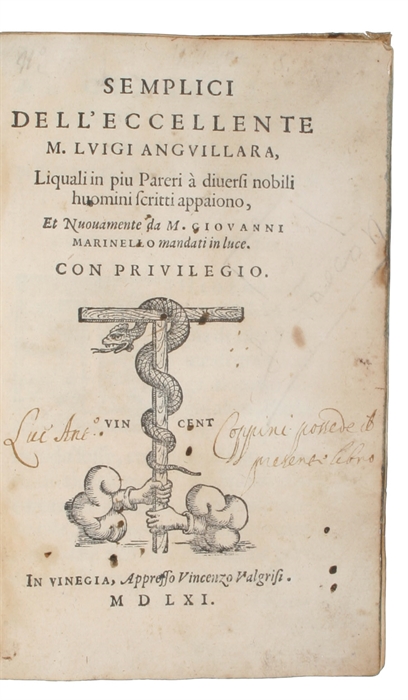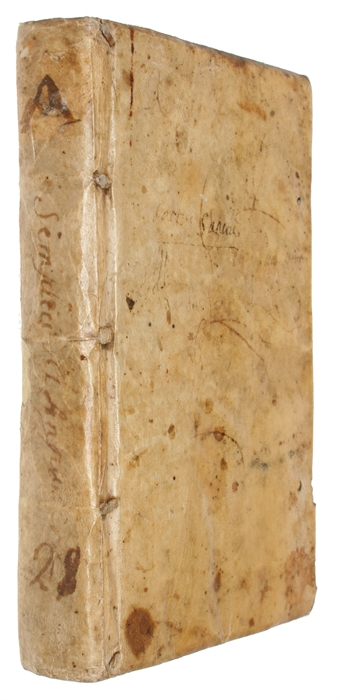THE GREATEST BOOK OF BOTANY EVER WRITTEN IN ITALY
ANGUILLARA, LUIGI -
Semplici Liquali in piu Pareri à diuersi nobili huomini appaiono...
Venegia (Venice), Vincenzo Valgrisi, 1561.
Small 8vo. Contemp. full vellum. Covers a bit soiled and with remains of ink-writing on both covers. Small nicks to edges. Endpapers renewed with old paper. Old written owners name on titlepage: Antonio Cappini. 304,(32) pp. A few stains and a few scattered brownspots. Faint browning to lower margin of some leaves. Fine woodcut initials throughout.
The extremely scarce first edition of this botanical classic, which still remains an important source for historical nomenclature and floristic studies.
"Little is known of Anguillara's early life. In 1539 he became associated with Luca Ghini at the latter's private botanical garden, first in Bologna, then in Pisa in 1544. Two years later, Anguillara became the first director of the botanical garden in Padua, the oldest of its kind in Europe. He remained at Padua, supervising a garden that received favorable notice from many distinguished visitors, until 1561... He became herbalist to the Duke of Ferrara and continued his botanical travels." (D.S.B. I:167).
The present work is Anguillara's only known book. The work was written over a long period (1549-60) and is divided into fourteen 'pareri' ("opinions"), each of which is dedicated to a contemporary Italian physician. "(t)he book is principally devoted to the identification of the plants known to Dioscorides and the other ancient writers on materia medica. Because of his travels in Greece, Italy, France, and Asia Minor and his great personal knowledge of plant life throughout the Meditarranean basin, Anguillare was among the best-equipped of sixteenth-century botanists to make such a study.
Approximately 1,540 plants are discussed by Anguillara, but in no discernible systematic order. Each plant is described, its classical name established (often with vernacular synonyms appended), and its medical and alimentary uses mentioned, along with its habitat, literary references, and the location where Anguillara found it. The descriptions are sufficiently full and accurate that the majority of his plants have been identified by modern historians of botany. Frequently cited by seventeenth-century botanists, the "Semplici" still remains an important source for historical nomenclature and floristic studies. He is commemorated today by the genus "Angillaria (Liliaceae)" named in his honor by Robert brown (1810)." (DSB, I:167).
Greene in his "Landmarks of Botanical History", calls this book "The greatest book of botany which had ever been written in Italy."- Pritzel: 187. - Waller: 430 - Graesse I: p. 131. - Not in Wellcome, not in Hunt, not in Jackson.
Order-nr.: 38894


